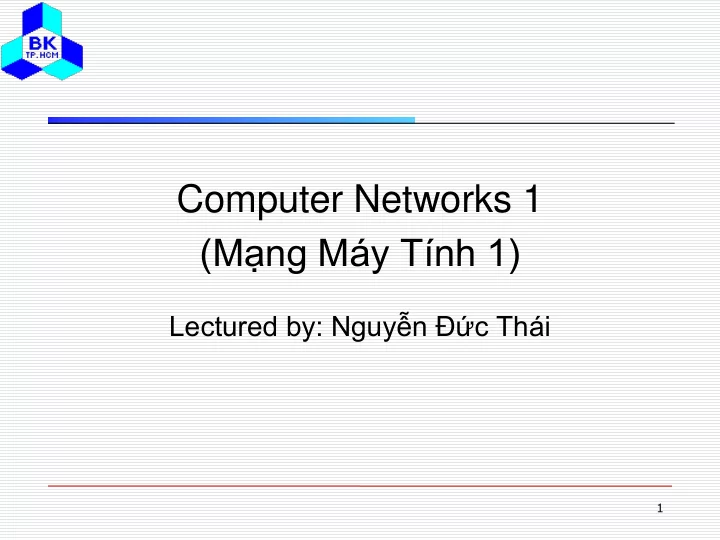

Computer Networks 1 (Mạng Máy Tính 1) Lectured by: Nguyễn Đức Thái 1
Lecture 7: Network Layer in the Internet Reference : Chapter 5 - “ Computer Networks ”, Andrew S. Tanenbaum, 4th Edition, Prentice Hall, 2003. 2
The Network Layer in the Internet The IP Protocol • IP Addresses • Internet Control Protocols • OSPF – The Interior Gateway Routing Protocol • BGP – The Exterior Gateway Routing Protocol • IPv6 • 3
Design Principles for Internet • Look for a good • Make sure it works. design; it need not be • Keep it simple. perfect. • Make clear choices. • Be strict when • Exploit modularity. sending and tolerant • Expect heterogeneity. when receiving. • Think about • Avoid static options scalability. and parameters. • Consider performance and cost. 4
Collection of Subnetworks The Internet is an interconnected collection of many networks. 5
The IP Protocol The IPv4 (Internet Protocol) header. 6
The IP Header Version : version of the protocol used IHL : header length (number of 32-bit words) Type of service : combination of reliability and speed, commonly ignored by routers Total length : length of the datagram Identification : to identify a fragment within a datagram DF : don’t fragment, tell the routers not to fragment MF : more fragments Time-to-live : a time counter to limit the message lifetime Header checksum : of the header only Source and destination addresses : address of the source and destination of the datagram 7
IP Options Some of the IP options. 8
IP Addresses IP address formats. 9
IP Address Classes Class A: 128 networks, 16 mil hosts each Class B: 16.384 networks, 64K hosts each Class C: 2 mil networks, 256 hosts each Class D: for multicast Class E: Reserved 10
IP Addresses (2) Special IP addresses. 11
Subnets A campus network consisting of LANs for various departments. 12
Subnet and Subnet Mask Some bits of the host are used to create subnet • number Subnet masks are used to indicate the splits • between network, subnet number and host number A class B network subnetted into 64 subnets (6 bits). 13
Routing with Subnetting Routing to destination to an outside network is done as usual Routing table adds more entries for routing within the network (this-network, subnet, 0): to route message to another subnet (this-network, this-subnet, host): to route message to a host within this-subnet 14
CIDR – Classless InterDomain Routing Allocate IP addresses in variable size block without • regard to classes If a site needs, it is provided with a block of • addresses Routing process is more complicated • A set of IP address assignments. 15
NAT – Network Address Translation Placement and operation of a NAT box. 16
NAT – Network Address Translation (2) Use TCP or UDP header (source port field) of a message to keep track of its outgoing connection A mapping table is used at the NAT box to keep track of the private IP + port the NAT index In coming message address is reversed back to original private IP and source port using the index 17
Internet Control Message Protocol Used when unexpected events occurred in the • network, also used to test the network The principal ICMP message types. 18
ARP – The Address Resolution Protocol Used to map an IP addresses to data link layer • addresses, e.g. Ethernet addresses Three interconnected /24 networks: two Ethernets and an FDDI ring. 19
Dynamic Host Configuration Protocol – DHCP A replacement for RARP (Reverse ARP) • and BOOTP (Bootstrap protocol) Operation of DHCP. 20
OSPF – Open Shortest Path First The Interior Gateway Routing Protocol To replace RIP (distance vector protocol) when the networks getting bigger Similar to Link State Routing Protocol Requirements: Open Support variety of distance metrics Dynamic Support service based routing Do load balancing Support hierarchical systems Security 21
OSPF (1) (a) An autonomous system. (b) A graph representation of (a). 22
OSPF (2) The relation between ASes, backbones, and areas in OSPF. 23
OSPF (3) The five types of OSPF messages. 24
BGP – Border Gateway Protocol The Exterior Gateway Routing Protocol For routing messages between Autonomous Systems Often constrained by: Politics Security Economic considerations Routers are configured with policies 25
BGP (1) Fundamentally a distance vector protocol Networks are grouped into 3 categories Stub networks: one connection to BGP graph Multiconnected networks: multiconnection to BGP graph, possibly handle third party traffic Transit networks: e.g. backbone, willing to handle third party messages 26
BGP (2) (a) A set of BGP routers. (b) Information sent to F. 27
IPv6 IPv4 address is going to be exhausted in the very near future IPv6 is introduced to cop with increasing demand for IP address 28
IPv6 Design Goals Support billions of hosts, even with inefficient address space allocation. Reduce the size of the routing tables. Simplify the protocol, to allow routers to process packets faster. Provide better security (authentication and privacy) than current IP. Pay more attention to type of service, particularly for real-time data. Aid multicasting by allowing scopes to be specified. Make it possible for a host to roam without changing its address. Allow the protocol to evolve in the future. 29 Permit the old and new protocols to coexist for years.
The Main IPv6 Header 30
IPv6 Address 16 byte length address Consists of eight groups of 4 hex digits with colon between groups 8000:0000:0000:0000:0123:4567:89AB:CDEF Leading zero can be ommited One or more groups of 16 zero bits can be replace by a pair of colons: 8000::123:4567:89AB:CDEF IPv4 addresses can be written as a pair of colons and old dotted decimal number: ::192.31.20.46 31
Recommend
More recommend